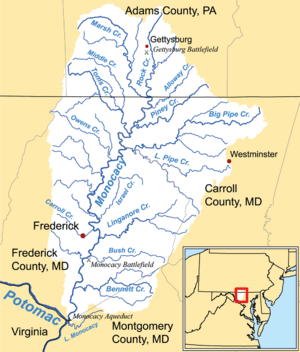Double Pipe Creek facts for kids
Double Pipe Creek, also known as Pipe Creek, is an important stream that flows into the Monocacy River. It's located in Carroll County and Frederick County in Maryland. Even though the main creek is only about 1.6 miles (2.6 km) long, it's formed by two much longer streams joining together: Big Pipe Creek and Little Pipe Creek.
Where Does Double Pipe Creek Flow?
The area that drains into Double Pipe Creek, called its watershed, stretches as far east as Manchester, Maryland. It includes towns like Union Bridge, Taneytown, New Windsor, and Westminster.
The main part of Double Pipe Creek starts when two other creeks meet:
- Big Pipe Creek is about 31.6 miles (50.9 km) long. It begins near Manchester.
- Little Pipe Creek is about 24.9 miles (40.1 km) long. It starts in Westminster.
These two creeks join near a place called Detour. From there, Double Pipe Creek flows west for about 1.6 miles (2.6 km) until it reaches the Monocacy River. The Monocacy River then flows into the Potomac River. The total area that drains into Double Pipe Creek is about 192.6 square miles (499 km²).
Some smaller streams that flow into Double Pipe Creek include Bear Branch, Meadow Branch, and Sam’s Creek. Parts of Double Pipe Creek, Little Pipe Creek, and Sam's Creek also form a natural border between Frederick County and Carroll County.
What About Water Quality in the Creek?
The Maryland Department of the Environment (MDE) has found some problems with the water quality in Double Pipe Creek and its smaller streams. These problems include too much sediment (like dirt and sand), too many nutrients (like nitrogen and phosphorus), and too much bacteria.
The main reasons for the bacteria seem to be:
- Broken septic tanks from homes or businesses.
- Pet waste.
- Waste from farm animals, like cows or chickens.
The extra sediment in the water comes from agricultural runoff (water flowing off farms) and urban runoff (water flowing off streets and buildings in towns). Even though most of the land around the creek is used for farming, parts of Westminster, Taneytown, New Windsor, and Union Bridge are also in the watershed.
A Look Back: Double Pipe Creek in History
Before the famous Battle of Gettysburg during the American Civil War, General George Meade, who led the Union Army, had a plan. He thought about setting up a strong defense line for his soldiers at Pipe Creek. This area had wide slopes and open fields, which would have been good for defending against an attack.
In some stories that imagine what might have happened differently, like the book Gettysburg by Gingrich and Forstchen, General Robert E. Lee (who led the Confederate Army) is shown using Pipe Creek as his own defense line.


